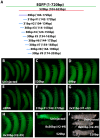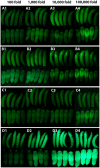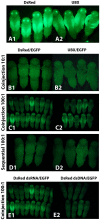Dissecting systemic RNA interference in the red flour beetle Tribolium castaneum: parameters affecting the efficiency of RNAi
- PMID: 23133513
- PMCID: PMC3484993
- DOI: 10.1371/journal.pone.0047431
Dissecting systemic RNA interference in the red flour beetle Tribolium castaneum: parameters affecting the efficiency of RNAi
Abstract
The phenomenon of RNAi, in which the introduction of dsRNA into a cell triggers the destruction of the corresponding mRNA resulting in a gene silencing effect, is conserved across a wide array of plant and animal phyla. However, the mechanism by which the dsRNA enters a cell, allowing the RNAi effect to occur throughout a multicellular organism (systemic RNAi), has only been studied extensively in certain plants and the nematode Caenorhabditis elegans. In recent years, RNAi has become a popular reverse genetic technique for gene silencing in many organisms. Although many RNAi techniques in non-traditional model organisms rely on the systemic nature of RNAi, little has been done to analyze the parameters required to obtain a robust systemic RNAi response. The data provided here show that the concentration and length of dsRNA have profound effects on the efficacy of the RNAi response both in regard to initial efficiency and duration of the effect in Tribolium castaneum. In addition, our analyses using a series of short dsRNAs and chimeric dsRNA provide evidence that dsRNA cellular uptake (and not the RNAi response itself) is the major step affected by dsRNA size in Tribolium. We also demonstrate that competitive inhibition of dsRNA can occur when multiple dsRNAs are injected together, influencing the effectiveness of RNAi. These data provide specific information essential to the design and implementation of RNAi based studies, and may provide insight into the molecular basis of the systemic RNAi response in insects.
Conflict of interest statement
Figures





Similar articles
-
Identification of a double-stranded RNA-degrading nuclease influencing both ingestion and injection RNA interference efficiency in the red flour beetle Tribolium castaneum.Insect Biochem Mol Biol. 2020 Oct;125:103440. doi: 10.1016/j.ibmb.2020.103440. Epub 2020 Aug 6. Insect Biochem Mol Biol. 2020. PMID: 32771566
-
Key factors determining variations in RNA interference efficacy mediated by different double-stranded RNA lengths in Tribolium castaneum.Insect Mol Biol. 2019 Apr;28(2):235-245. doi: 10.1111/imb.12546. Epub 2018 Nov 14. Insect Mol Biol. 2019. PMID: 30325555
-
A Systematic Study of RNAi Effects and dsRNA Stability in Tribolium castaneum and Acyrthosiphon pisum, Following Injection and Ingestion of Analogous dsRNAs.Int J Mol Sci. 2018 Apr 4;19(4):1079. doi: 10.3390/ijms19041079. Int J Mol Sci. 2018. PMID: 29617308 Free PMC article.
-
Parental RNA interference (pRNAi) in insects: mechanisms, applications, and challenges in pest management.Mol Biol Rep. 2025 Jun 18;52(1):610. doi: 10.1007/s11033-025-10700-2. Mol Biol Rep. 2025. PMID: 40531353 Review.
-
RNAi as a Foliar Spray: Efficiency and Challenges to Field Applications.Int J Mol Sci. 2022 Jun 14;23(12):6639. doi: 10.3390/ijms23126639. Int J Mol Sci. 2022. PMID: 35743077 Free PMC article. Review.
Cited by
-
Localized efficacy of environmental RNAi in Tetranychus urticae.Sci Rep. 2022 Aug 30;12(1):14791. doi: 10.1038/s41598-022-19231-3. Sci Rep. 2022. PMID: 36042376 Free PMC article.
-
Assessing the Risks of Topically Applied dsRNA-Based Products to Non-target Arthropods.Front Plant Sci. 2020 Jun 4;11:679. doi: 10.3389/fpls.2020.00679. eCollection 2020. Front Plant Sci. 2020. PMID: 32582240 Free PMC article.
-
Crowdsourced Identification of Potential Target Genes for CTV Induced Gene Silencing for Controlling the Citrus Greening Vector Diaphorina citri.Front Physiol. 2021 Apr 9;12:571826. doi: 10.3389/fphys.2021.571826. eCollection 2021. Front Physiol. 2021. PMID: 33897443 Free PMC article.
-
RNA Interference in Insects: Protecting Beneficials and Controlling Pests.Front Physiol. 2019 Jan 11;9:1912. doi: 10.3389/fphys.2018.01912. eCollection 2018. Front Physiol. 2019. PMID: 30687124 Free PMC article. Review.
-
Environmental fate of double-stranded RNA in agricultural soils.PLoS One. 2014 Mar 27;9(3):e93155. doi: 10.1371/journal.pone.0093155. eCollection 2014. PLoS One. 2014. PMID: 24676387 Free PMC article.
References
-
- Fire A, Xu S, Montgomery MK, Kostas SA, Driver SE, et al. (1998) Potent and specific genetic interference by double-stranded RNA in Caenorhabditis elegans. Nature 391: 806–811. - PubMed
-
- Meister G, Tuschl T (2004) Mechanisms of gene silencing by double-stranded RNA. Nature 431: 343–349. - PubMed
-
- Mello CC, Conte D Jr (2004) Revealing the world of RNA interference. Nature 431: 338–342. - PubMed
-
- Lippman Z, Martienssen R (2004) The role of RNA interference in heterochromatic silencing. Nature 431: 364–370. - PubMed
-
- Bernstein E, Caudy AA, Hammond SM, Hannon GJ (2001) Role for a bidentate ribonuclease in the initiation step of RNA interference. Nature 409: 363–366. - PubMed
Publication types
MeSH terms
Substances
Grants and funding
LinkOut - more resources
Full Text Sources

